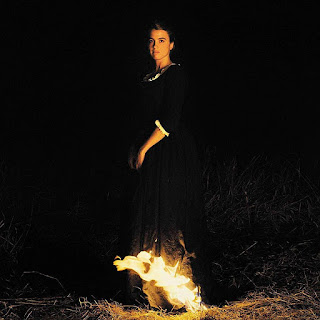Portrait of a Lady on Fire
On Friday, the Landmark Theaters in Santa Monica screened the French film "Portrait of a Lady on Fire."
Céline Sciamma's "Portrait of a Lady on Fire" shows the romantic and creative relationship between a painter and her subject. In the painting of the portrait and in the budding romance, eyes, image, and the lover's gaze is emphasized. Lauded cinematographer Claire Mathon creates her own version of 18th century, pre-revolutionary France while distilling the poise and stillness of the period in long gazes and single shots.
The movie begins as artist Marianne (Noémie Merlant) arrives to an aristocratic family's estate in Brittany after being invited to paint the young mistress, Héloise (Adèle Haenel), before her arranged marriage to a Milanese nobleman who insists on accepting her portrait before hand. After refusing to pose for the last hired portraiteur, Héloise is made to believe Marianne is her walking partner by her troubled mother. It is not until 20 minutes into the movie that Héloise's face is revealed after a long shot of her from behind, shrouded in a hooded cloak. The first look between the two women is one of understanding and preemptive nostalgia that sets the stage for many knowing stares which hinge on Marianne's reveal that she has come to paint Héloise. With this confession, Héloise, who by this point has taken a liking to her "walking companion," becomes willing to pose and collaborate, a partnership that loosens the rigidity and technicality of Marianne's artistry. This transformation in art is microcosmic of a transformation in relationships for both women. Free of technique and custom, friendship and love become a vital experience.
An unwanted pregnancy and subsequent abortion by a "witch" builds the epochal marginalization of women directly into the subplot of the movie. After Marianne resents the prevention of women artists from "great subjects," Héloise suggests the abortion as a subject for her work, putting a fundamentally female experience onto canvas. The characterization of witches as herbalists and naturalists redefines them as wise women. Héloise's societal bind is defied in her relationship with Marianne as they prepare her for arranged marriage.
The scene pictured above comes at the end of a long scene at a gathering of naturalist women. There's chant-like singing in the background as Héloise and Marianne lock eyes for a prolonged time. This is later referenced as the moment Héloise most wanted to kiss her companion. There is a lack of control (of the elements and of emotion) divergent from the technicality of Marianne's prior passion, yet neither women is in terror as Héloise burns.
The movie begins as artist Marianne (Noémie Merlant) arrives to an aristocratic family's estate in Brittany after being invited to paint the young mistress, Héloise (Adèle Haenel), before her arranged marriage to a Milanese nobleman who insists on accepting her portrait before hand. After refusing to pose for the last hired portraiteur, Héloise is made to believe Marianne is her walking partner by her troubled mother. It is not until 20 minutes into the movie that Héloise's face is revealed after a long shot of her from behind, shrouded in a hooded cloak. The first look between the two women is one of understanding and preemptive nostalgia that sets the stage for many knowing stares which hinge on Marianne's reveal that she has come to paint Héloise. With this confession, Héloise, who by this point has taken a liking to her "walking companion," becomes willing to pose and collaborate, a partnership that loosens the rigidity and technicality of Marianne's artistry. This transformation in art is microcosmic of a transformation in relationships for both women. Free of technique and custom, friendship and love become a vital experience.
An unwanted pregnancy and subsequent abortion by a "witch" builds the epochal marginalization of women directly into the subplot of the movie. After Marianne resents the prevention of women artists from "great subjects," Héloise suggests the abortion as a subject for her work, putting a fundamentally female experience onto canvas. The characterization of witches as herbalists and naturalists redefines them as wise women. Héloise's societal bind is defied in her relationship with Marianne as they prepare her for arranged marriage.
The scene pictured above comes at the end of a long scene at a gathering of naturalist women. There's chant-like singing in the background as Héloise and Marianne lock eyes for a prolonged time. This is later referenced as the moment Héloise most wanted to kiss her companion. There is a lack of control (of the elements and of emotion) divergent from the technicality of Marianne's prior passion, yet neither women is in terror as Héloise burns.



This looks incredible. I'll have to check it out.
ReplyDelete